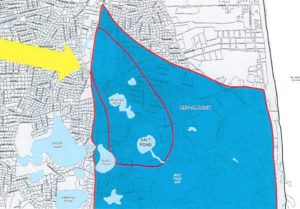EASTHAM — The people living near Salt Pond will likely be the ones who must hook up to a sewer system in order for Eastham to get a targeted watershed management plan approved by the state.
Town staff say they cannot be any more specific yet about which homeowners will be among the approximately 600 in all who will be required to hook up to a planned sewer system. The design and engineering of the first phase of that system will go before voters next spring at the annual town meeting. According to the current timeline, construction would begin in 2025.

Last month, J. Jefferson Gregg and Jessica Janney, project managers for GHD, a global engineering consulting firm with offices in Hyannis, provided the town with an update on the wastewater infrastructure plans that have been underway for years. The plan is designed to reduce nitrogen from septic systems that are currently polluting water bodies.
The neighborhoods on the ocean side of the Cape Cod Rail Trail beginning at Depot Pond and moving north to the town DPW area fall within the phase one area of the plan. This includes neighborhoods around Salt Pond, Depot Pond, Ministers Pond, and Moll Pond.
Town Administrator Jacqui Beebe said the consultants are still studying which houses will be required to hook up.
“At this point, we do not even have cost estimates for the design and engineering,” she said. “So, everyone will have to wait a couple more months — as we will — to have more refined information.” The consultants and staff will return in January for more concrete discussions about numbers and cost estimates, Beebe added.
The town has been trying to clean up Salt Pond and the Nauset Estuary for many years. Testing of Salt Pond from 2001 to 2020 found that nitrogen levels were almost always above the state’s targeted level of .45 milligrams per liter.
Septic systems are the major reason why. So, the town proposes to build sewers in priority areas.
About 250 sewer connections are proposed in phase one and 280 in phase two, along with another 60 connections to commercial properties on the highway, Janney said. The sewer pipes for phase one will transport wastewater to a treatment facility at the transfer station at 555 Old Orchard Road.
Other potential sites for a treatment system, including the T-Time parcel on Route 6 and the sand pit at 2760 Nauset Road, have been ruled out because treated wastewater released at the transfer station will take the longest to travel to the municipal water wells, according to groundwater modeling, Gregg said.
Motivation to clean up Salt Pond is coming from the state Dept. of Environmental Protection, which has issued draft regulations requiring every town to submit a targeted watershed management plan to clean up impaired water bodies or face a requirement that every property owner living near these water bodies be made to install high-nitrogen-removal wastewater systems, which cost approximately $30,000 each.
Exactly who will pay the millions of dollars needed for sewer infrastructure remains unknown, but the town would be able to apply for zero-percent loans and use American Rescue Plan Act funds for the purpose. Property owners will probably be charged hookup fees, but an exact formula has not been determined.
On Nov. 21, the select board asked Gregg about the quality of the treated effluent from a treatment facility on Old Orchard Road.
“I’m wondering what the risk to our wells would actually be if we put a facility at the DPW,” said board member Suzanne Bryan.
Gregg’s response was definitive.
“Right now, you have no treatment on any of your septic systems that go to those wells,” Gregg said. “So, it’s the same risk you have now, except you have a higher level of treatment.” With treated wastewater, he said, “you’re doing a better job.”
The Salt Pond watershed is the focus of the first phase of the town’s plan. Phase two addresses the larger area known as the Nauset Estuary. It extends from the transfer station to Town Cove in Orleans on the ocean side of the Rail Trail.
The town is “in discussions for a regional approach” with Orleans, which is scheduled to open a wastewater facility in January to provide treatment to homes around Town Cove and possibly Rock Harbor, according to Gregg.
“Is there an opportunity for any partnerships?” Gregg said. “The town is exploring that.”
Otherwise, building sewer pipes from South Eastham to the DPW facility will be costly.



